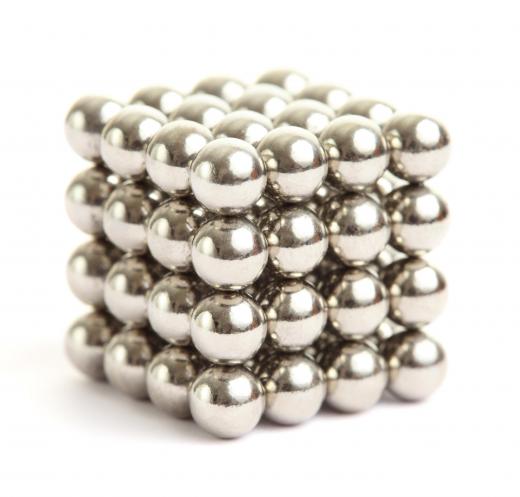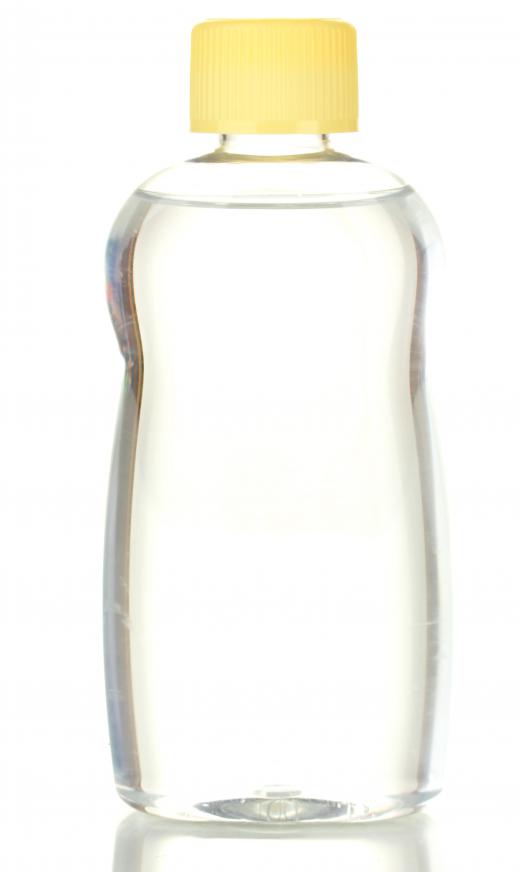What Is Neodymium?
 Mary McMahon
Mary McMahon
Neodymium is a metallic chemical element classified in the rare earth group of the periodic table. Despite the “rare” in its elemental group, neodymium is actually relatively abundant in the Earth's crust, usually in compounds which form various minerals. It can also be found in some mixed metal ores, which are processed in various ways to yield separated metal products. Consumers are probably most familiar with neodymium in the form of extremely powerful magnets made from a neodymium alloy.
In appearance, the element is silvery in color, and extremely bright. However, it oxidizes quickly, so it needs to be stored in mineral oil or other neutral conditions for the brilliant, shiny color to be retained. Neodymium also has a number of salts and isotopes which are used in various industrial applications; the appearance of these derivatives of the element vary. On the periodic table, the element is identified with the symbol Nd, and it has an atomic number of 60. It rarely appears in a pure form in nature, due to its reactivity with the air.

Baron Carl Auer von Welsbach is typically given the credit for the discovery of this element, in 1885. He was conducting studies on a material known as didymium which had been discovered by Carl Mosander in 1841, and ultimately used a fractional distillation technique to extract the neodymium from this compound. Mosander believed that his discovery was a new element, and he named it after the Greek didymos, for “twin,” a reference to its close resemblance to lanthanum. Welsbach named his discovery the “new twin” after realizing that didymium was not in fact a pure element.

A pure form was not isolated until 1925, and it took several more years to develop an affordable technique for extracting it. In addition to being used in magnets, the element is employed in optical materials, glass coloring, pottery glazes, and various metal alloys. Neodymium is a common component of misch metal, a metal alloy which is used in things like flints for lighters. These compounds are also sometimes given as an intravenous anticoagulant.

Like other rare earth metals, this element is believed to be of low to mild toxicity. Dust from the metal can certainly irritate mucus membranes such as those found in the mouth, nose, eyes, and lungs. Care should also be taken around neodymium fumes and vapors produced when the metal is processed, and people may want to avoid ingesting it, if possible.
AS FEATURED ON:
AS FEATURED ON:














Discussion Comments
Yes, the neodymium magnet is more powerful than any other magnetic material. So it's fantastic to use it in industry.
As to what are they good for, you should check out an SEG (Searl Effect Generator) by professor John Searl. He was an absolute genius. He hung out with Tesla.
Has anyone experienced swelling of your hands or face after playing with BuckyBalls? We are having some problems
@JimmyT - As far as I know, I don't think there is any reason using a neodymium magnet on a refrigerator would affect anything. I've done it before, and magnets will still stick just fine.
There are a lot of household uses for the magnets. One of the most popular uses is to remagnetize old magnets. Since the neodymium magnets are so strong, you can actually rearrange the molecules in a regular magnet to make it more effective.
I read something recently, too, about being able to use a magnet as a stud finder. You just take a magnet and move it around the wall until it sticks to a nail under the surface. I haven't tried it, but I don't see why it wouldn't work.
I am curious though where in the world neodymium is most abundant. Give the name of the discoverer, I'm guessing it exists around Germany.
I've heard of neodymium magnets and have seen how powerful they are, but is there any reason someone should have some lying around the house? Besides being strong, is there anything they can do that a regular magnet can't do?
Also, I have heard that putting neodymium magnets on your refrigerator will stop regular magnets from sticking to it. Is this true?
@Izzy78 - That magnet set sounds really neat. I've always loved playing with things like that.
Just some words of advice for people that have neodymium magnets: make sure you keep them away from credit cards! Even a regular refrigerator magnet can erase credit cards in some cases, but these magnets are almost guaranteed to do it.
I had a couple of the magnets in my pocket once and accidentally put my credit card in the same pocket after I used it. The next time I tried to buy something, the card wouldn't register. Besides the experience being slightly embarrassing, I had to pay to get a new card, also.
I love playing with neodymium magnets. It's incredible how strong they can be. A lot of times, you can put magnets on both sides of your hand and they will still be able to stick together.
I recently bought a set of neodymium magnets online. The magnets are small and round, and there are 216 of them that come as a 6x6x6 cube. Since the magnets are so strong, you can make tons of shapes and designs with the small magnets. You can find the sets online for around 15 or 20 dollars. They are extremely fun to play with.
Post your comments